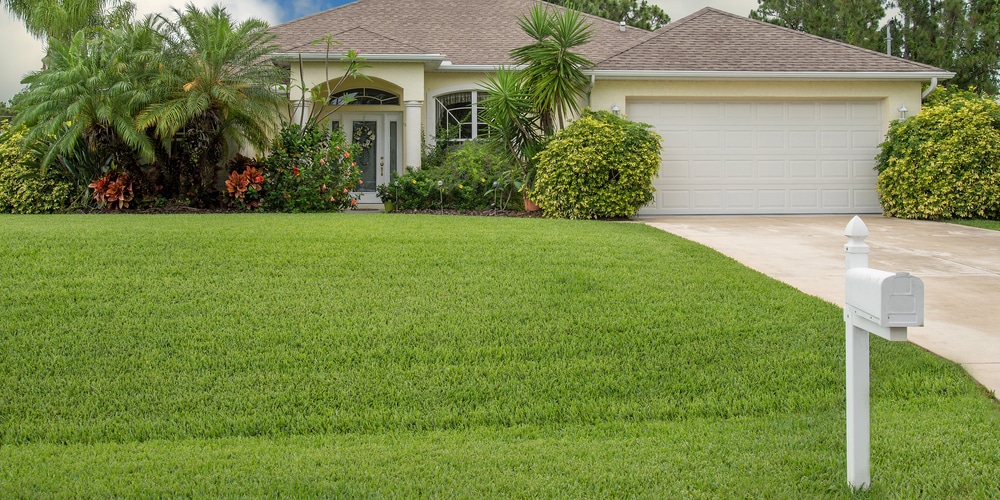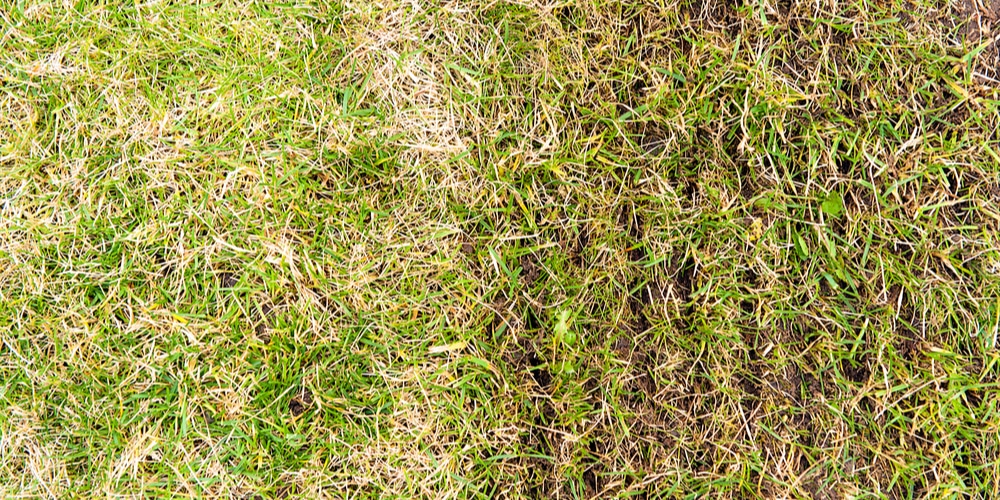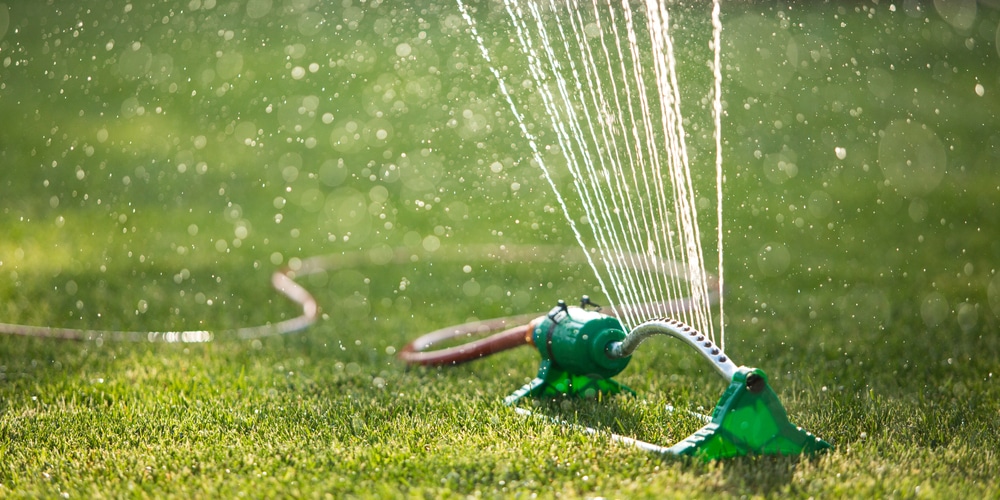Top Dressing and Lawn Health
Top dressing is a lawn care technique designed to improve soil quality and promote healthy grass growth.
The process involves spreading a thin layer of material, usually compost or mixed soil, over the lawn.
Here are the key aspects of top dressing and its contributions to your lawn’s wellbeing:
- Soil Structure Improvement:Top dressing can enhance your lawn’s soil structure by adding organic matter.
This can lead to better water retention, drainage, and root penetration.
A healthier soil structure supports robust grass growth and resilience against pests and diseases.
- Thatch Breakdown:Thatch is a layer of organic debris between the green grass and the soil surface.
A moderate layer of top dressing accelerates the decomposition of thatch, promoting a balanced ecosystem within your lawn.
Learn more about thatch control.
- Nutrient Supply:The materials used for top dressing, particularly compost, can provide an excellent source of nutrients.
This slow-release fertilization helps maintain sustained grass growth throughout the season.
- Evening Out Surface:Minor bumps and dips in your lawn can be smoothed out with top dressing, creating a more even surface that’s not only visually appealing but also safer and easier to maintain.
- Encouraging Growth:Top dressing can encourage the development of new grass shoots, resulting in a denser lawn.
Remember to top dress during the growing season when your lawn can recover quickly, usually in the spring or fall.
Apply a quarter to half an inch of your chosen material and ensure even distribution to avoid smothering the grass.
Assessing Your Lawn’s Condition
Before diving into revitalization techniques, it’s pivotal to accurately gauge the state of your lawn.
Thoroughly examining the soil, determining grass types, and identifying any evident lawn issues are your first steps toward a vibrant lawn.
Evaluating Soil Quality
- Texture and Composition:
- Squeeze a small amount of soil in your hand. If it holds its shape but crumbles with a poke, it has a balanced mix of sand, silt, and clay.
- Drainage:
- After watering, observe how quickly the water drains. Soil that takes a long time to drain may have high clay content, which can affect grass health.
- pH Level:
- A simple soil pH test can reveal if your soil is too acidic or alkaline, each of which can hinder grass growth and should be adjusted.
Identifying Grass Types
- Cool-Season Grasses:
- These grasses, such as Kentucky bluegrass and fescue, thrive in cooler temperatures and may need different care compared to warm-season varieties.
- Warm-Season Grasses:
- Species like Bermuda and Zoysia are better suited for hot weather and might require distinct maintenance practices.
- Grass Health:
- Examine the color and thickness of your lawn’s grass. Healthy grass should be a vibrant green and dense, indicating good soil health and proper care.
Spotting Common Lawn Problems
- Bare Patches:
- Look for areas without grass, which can result from heavy foot traffic, pet activities, or pests.
- Weed Infestation:
- Note the presence of weeds, as they compete with grass for nutrients and sunlight.
- Pest and Disease Signs:
- Discolored, thinning, or patchy grass can signal underlying issues like fungal diseases or pest infestations.
Materials and Tools for Top Dressing
Optimal lawn care depends on providing your lawn with the right materials and using the right tools for top dressing, which can help your grass recover from winter and enter spring with vigor.
Choosing the Right Top Dressing Mix
The foundation of top dressing is selecting the appropriate mix, which generally includes a balanced blend of:
- Sand:
- Improves drainage and breaks up compacted soil.
- Loam:
- The ideal middle-ground soil that provides nutrients and retains moisture but not excessively.
- Peat:
- Assists in retaining moisture and protecting grass roots.
For best results, match the mix closely to your existing soil structure, or choose a mix that addresses specific deficiencies in your soil.
Top Dressing Equipment and Tools
To efficiently apply the top dressing, you’ll need the following tools:
- Shovel or Scoop:
- For loading dressing onto your lawn or into a spreader.
- Wheelbarrow:
- To transport the mix across your lawn.
- Lawn Leveling Rake or Lute:
- For spreading and leveling the mix evenly across the grass.
- Peat Moss Spreader:
- Beneficial when using peat-based mixtures for an even application. (learn more about peat moss spreaders for top dressing)
- Garden Hose with Sprinkler Attachment:
- To water in the top dressing, integrating it with the existing soil. (read about watering your lawn after top dressing)
Starting with a small amount of top dressing allows you to gradually build up without smothering your grass.
Top Dressing Application Techniques
Proper application of top dressing can significantly enhance the health and appearance of your lawn. In this section, we’ll explore when to apply top dressing and walk through the procedure to ensure your lawn reaps maximum benefits.
Timing and Weather Considerations
- Choose the right time:
- Spring is ideal for top dressing, as the growing season is just beginning.
- Monitor the weather:
- Aim for a period of mild, wet weather to help the dressing integrate with the soil.
Step-by-Step Top Dressing Procedure
- Measure your lawn to determine the amount of top dressing you will need.
- Prepare the top dressing mixture, ensuring it is dry and crumbly to the touch.
- Mow your lawn to a short length, and, if possible, aerate it to improve soil composition and facilitate the integration of the dressing.
- Apply the top dressing evenly across your lawn using a shovel or spreader designed for the task.
- Start with a thin layer, about ¼ to ½ of an inch, to avoid smothering your grass.
- Work the dressing into the lawn using the back side of a rake or a brush, ensuring that it makes contact with the soil beneath the grass.
- Water your lawn lightly to help the top dressing settle.
Post-Top Dressing Lawn Care
After top dressing your lawn, specific care steps are crucial to ensure the best results. The success of the top dressing largely depends on how you water and maintain your lawn afterward.
Watering After Top Dressing
- Immediately after application:
- Begin by lightly watering your lawn to help settle the top dressing material.
- Aim for moistening the top inch of soil without causing runoff.
- Then, follow this watering schedule for the next few days:
-
- Day 1-3: Water once daily, maintaining slight moisture at the soil’s surface.
- Day 4-7: Reduce watering frequency to every other day, encouraging deeper root growth.
Mowing and Maintenance Schedule
- Wait time before mowing:
- Allow your grass to recover for at least 2 weeks before resuming mowing. This rest period is essential for root establishment and to avoid disrupting the newly applied material.
-
- First mow:
- Set your mower to a high setting to prevent stress on the lawn.
- Ongoing care:
- Resume regular mowing with the blade raised slightly higher than usual for the next few cuts.
Frequently Asked Questions
In this section, we’ll tackle common concerns when it comes to giving your lawn the springtime boost it needs with top dressing. Here, you’ll find concise expert advice on the right products and techniques to revitalize your lawn.
What type of top dressing is most effective for reviving lawns in spring?
The most effective top dressing for reviving your lawn in spring includes mixes that are tailored to your lawn’s specific needs.
If your lawn receives a lot of sunlight, a full-sun mix is ideal. For shadier areas, choose a product designed to thrive in reduced light.
Additionally, look for mixes that incorporate weed preventers for a healthier lawn.
Is it better to overseed before or after applying top dressing?
You should overseed before applying top dressing to allow the seeds to settle directly onto the soil.
The top dressing can then be applied to ensure even distribution and optimal seed-to-soil contact, improving germination rates.
Where can I purchase high-quality top dressing for my lawn?
High-quality top dressing for your lawn can be purchased from garden centers, landscape supply companies, or home improvement stores.
For organic options, you might consider products like MicroLife Multi-Purpose 6-2-4, which is available at specialty gardening shops.
What are the primary benefits of applying top dressing to a lawn?
Top dressing provides several benefits:
- Enhances soil quality and structure
- Improves nutrient retention
- Aids in the decomposition of thatch
- Assists in leveling the surface of the lawn
What is the optimal timing for top dressing a lawn in regions with climates similar to Texas?
For regions with climates similar to Texas, the optimal time for top dressing a lawn is in the early spring.
This coincides with the growing season, allowing the lawn to recover quickly and utilize the top dressing effectively.
How should I go about reviving a lackluster lawn at the beginning of spring?
To revive a lackluster lawn at the beginning of spring:
- Test the soil’s pH and nutrient content to ensure they fall within an ideal range. These are typically between 6.0 and 7.5 for lawn soil.
- Choose a suitable seed mix specific to the current condition and type of your lawn.
- Overseed and then apply top dressing for better seed germination.
- Keep the area watered according to seed and product recommendations to promote lush growth.
Last update on 2025-04-02 / Affiliate links / Images from Amazon Product Advertising API





